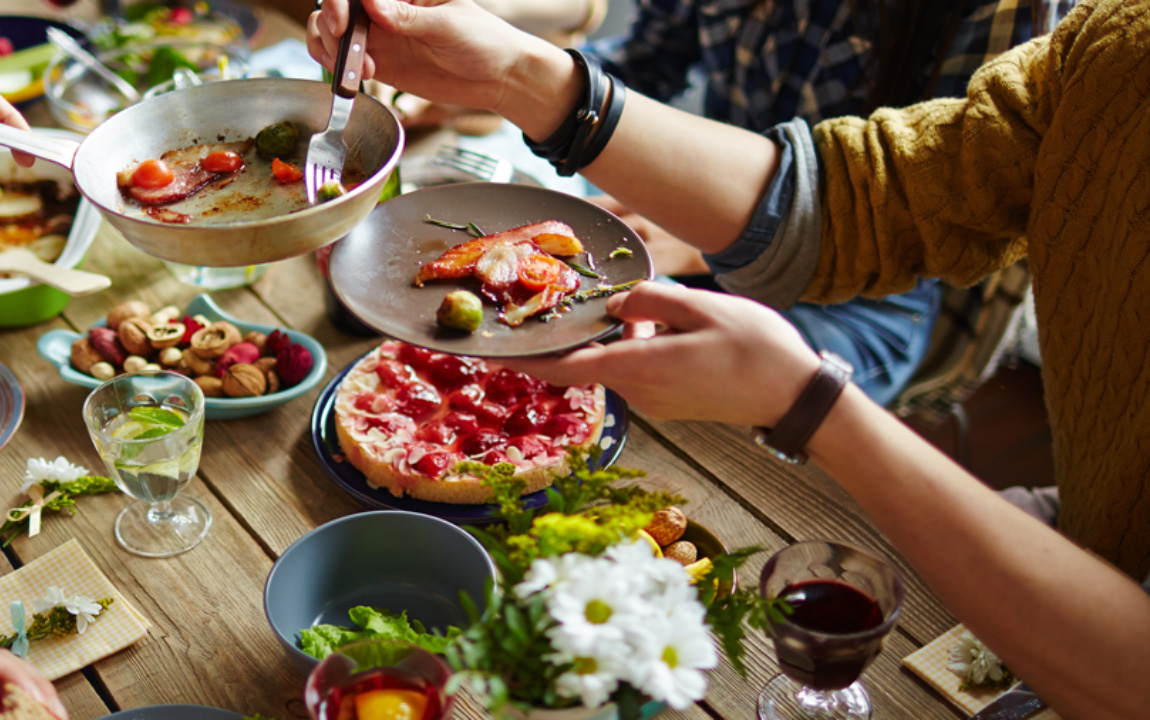Today’s consumers go beyond the supermarket shelf to learn more about how their food is produced as we become a more food-savvy culture. The reason is quite simple.
What you put on your plate has the potential to have the greatest effect on your own environmental footprint. Consciously or unconsciously, you make decisions three times a day about how to quiet your grumbling stomach and feed your body—decisions that may affect Mother Earth.
Plant foods are produced in the modern agricultural system using synthetic pesticides and fertilizers, and fossil fuels damage soils and encourage monocultures. These plants are given to animals, often concentrated on farms where the animals have short, unhappy lives. Their manures are concentrated, polluting soils, rivers, and the atmosphere.
Also, food often travels great distances to reach our plates, and we squander about 40% of the food we produce! So, how are we going to change everything? Well, the change will need to start with you!
What Do We Mean By Sustainable Food Solutions?
There are various ways to describe food sustainability. However, it may be included in the broader definition of “sustainability,” which is defined as “the ability for everyone to live well within the Earth’s natural limitations.” Although this is a simple description, attaining it is one of humanity’s biggest problems in the twenty-first century.
How can we guarantee that everyone gets enough safe and cheap food to support human health and illness prevention? Simultaneously, how can we maintain the health of our planet’s ecosystems, which supply the essential resources we all rely on? Let’s take a look at 10 ideas for eating sustainably for both your personal health and the health of our world.
10 Tips For Eating Sustainably
1. Consume as many fruit & vegetables as possible.
Fruits and vegetables are healthy and have a minimal environmental effect in most cases. There are some exceptions; however certain foods take many resources to transport and keep fresh, so eating them less often may help us eat more sustainably. You should avoid –

- fruits and vegetables that are perishable or need refrigeration (salads & berries)
- veggies cultivated in a controlled environment (such as hot-house tomatoes or cucumbers)
- foods that need huge resources to transport (green beans, mange-touts, or berries imported from the southern hemisphere)
2. When in season, eat locally.
Try to include seasonal vegetables from your local farm store into your diet. You may get to know local farmers, learn how to cook seasonal meals and support your local economy.
Foods that travel great distances are usually not viable. The environmental effect is significant when you buy fruits in the winter from faraway places that are brought in by air. However, bear in mind that certain locations, even though they are a little farther away, are more effective at growing things. For example, the climate in California may make certain food more sustainable than produced in a heated greenhouse.
3. There is no need to waste anything.
Did you know that a third of the food produced on the planet is thrown away?
Food production consumes a lot of energy, water, fertilizer, land, and fuel. When food is thrown out, it contributes to pollution of the land, water, and air. That’s a lot of resources to spend on something that will wind up in a landfill!
Tips for minimizing food waste at home:
- Make a weekly food plan and use it to make your shopping list.
- Keep a calendar or a notebook handy to keep track of the dates you prepare meals.
- Turn leftovers into a fresh and delicious meal by adding sauces, vinegar, or spices.
- Make a stir-fry, a casserole, a salad, or a soup using leftover veggies.
- Make French toast, croutons, or breadcrumbs out of old bread.
- Food that has been left over should be frozen before it spoils. It will be a lifesaver on hectic days!
- Make use of all of the vegetable’s parts. Carrot and celery trimmings, for example, may be preserved to create vegetable stock. Also, broccoli stems can be shredded to produce broccoli “rice.”
4. Eat, Think, Meat.
Keep in mind where your meat comes from when purchasing it; choose meat from ethical suppliers. Is there a farmer or butcher in your area that does this? If you talk to them, you may learn a thing or two! Don’t always stick to the same, well-known cuts of meat. Try cow shin, which becomes very soft when simmered, or lamb chuck, ideal for a stew.
Red meat is already recommended as a condiment rather than a major meal. Meat production, particularly beef production, contributes significantly to greenhouse gas emissions. The environmental burden grows since animals need more food, water, land, and energy to raise and transport than plants. Non-meat proteins such as nuts and legumes should be considered while eating for our personal health and the world’s health.
5. Choose seafood responsibly.
Approximately 94% of fish populations are either overfished (34%) or fished to their maximum sustainable yield (60%), and aquaculture has its own set of problems. However, when seafood is appropriately produced, it may benefit people, the environment, and the climate. Try various species from well-managed sources, eat lower on the food chain, and choose seafood with a reduced carbon footprint.
6. Limit the visit to grocery stores.
Reduce the number of times you go grocery shopping. According to studies, the distance travelled to purchase groceries has a significant effect on the overall number of kilometres meals travel to reach your plate. So, to make the most of your location, consider reducing the number of visits you take and condensing your food transport journeys. For example, if you’re going to the farmers market, make all of your food-related visits there for the week.
7. Eat slowly & deliberately.
Mindful eating is one of the easiest ways to eat more sustainably. Concentrating on your food enables you to consider where it comes from and how it is feeding your body. Additionally, by paying attention to your hunger signals, you may discover that you don’t need as much food as you previously consumed. We may change our food intake and decrease food waste by paying more attention to eating and thinking about the “larger picture”.
8. Consume dairy products only in moderation.
While milk and dairy products have a significant environmental effect, dairy products are a good source of protein, calcium, and essential amino acids and have a lower risk of metabolic syndrome, high blood pressure, stroke, bowel cancer, and type 2 diabetes.
- Daily use of low-fat, unsweetened dairy products is recommended, but only in moderation.
- High-fat cheeses should only be consumed on rare occasions.
- Choose plant-based beverages fortified with vitamins and minerals, such as calcium, if you want to avoid dairy altogether.
9. Don’t stress about organic.
Organic food is, by definition, more costly than its conventional equivalents. Organic farmers must pass a series of time-consuming and expensive inspections to be certified. This questions, are organics really sustainable?
Well, it’s a little complicated, and there are many arguments for and against organic farming. The majority of studies so far have shown that organic and conventional farms have about the same environmental effect. Organic agriculture may worsen the environment since it requires more space and is less effective at producing crops. If you want to learn more, I recommend watching this Kurzgesagt video.
So, don’t worry if you can’t afford organic produce. It’s equally as sustainable to eat locally grown seasonal veggies.
10. Grow, Grow, Grow Your Own!
If you want to start producing your own fruit and/or vegetables, you can, regardless of where you live. Hardy herbs that don’t need much care, just a little water here and there, thrive in window boxes. Basil, rosemary, mint, and thyme are all wonderful herbs that may be grown in your own house. Simple!
You may also save money by making your own food since you are not paying for manufacturing and packing. There are no food miles, no packaging, no fossil fuels, just the pleasure of spending time in the dirt with live, breathing plants in the sun. What could possibly be better than that?
Tell Us About You!
Now that you’ve got some ideas on how to eat more sustainably, put them to work! What modest adjustments can you make to improve your body’s and the planet’s health? We’d love to hear from you!

